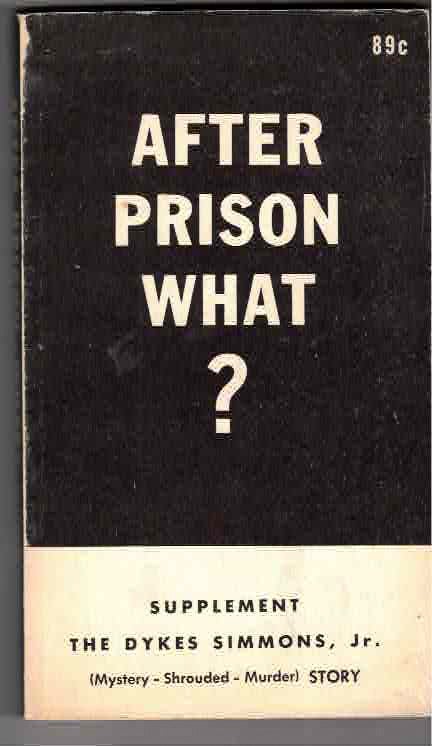
CIVIL RIGHTS AND HUMAN BROTHERHOOD
After Prison What?; Supplement: The Dykes Simmons, Jr. (mystery - shrouded - murder) story
Vista, Calif. The author, [1967]. First edition. Publisher's wrappers, 160 pp., 18 cm., illustrated. Near fine. Jones's memoir of his travels around the U.S. for more than 30 years, preaching non-discrimination, promoting civil rights and peace. He was frequently arrested and imprisoned, at one time held two months for eating in a Black restaurant, and another time eight months for attempting to integrate a Georgia church. His was the first case of an American persecuted for his political beliefs to be taken up by the newly-founded Amnesty International (see Peter Benenson, "Persecution 1961", Penguin Books 1961). Item #32407
"Appearing at the [Pasadena Friendship Baptist] church on July 12, 1965, [Martin Luther King Jr.] also seized a rare opportunity to meet a fellow crusader in the civil rights movement—the Rev. Ashton Jones of San Gabriel, who was associate pastor at the People’s Independent Church of Christ in Los Angeles.
Like King, Jones was a native of Georgia, but unlike King, he was white. Born in 1896, Jones began advocating for racial equality in his native South while a young man and eventually became one of the most dedicated activists in the civil rights movement.
Espousing a similar commitment to nonviolence, Jones was arrested 40 times between 1954 and 1966 for acts of civil disobedience. In 1963, he traveled to Atlanta, where he and several African-American students, as well as a white girl, attempted to integrate the segregated First Baptist Church, which only allowed blacks to attend services in the basement.
Jones was arrested for “disturbing a church worship” and served eight months in a Georgia prison, where he was beaten by guards and thrown in solitary confinement. He went on hunger strike twice to protest his treatment before being released on bail. ('I’ll be glad to go back whenever I’m called,' he later told the Los Angeles Times.)
Jones ... organiz[ed] a sit-in in Monterey Park in 1962 when a real estate developer refused to sell a land tract to a black physicist and his wife, leading a prayer for King on the steps of City Hall and later blocking the entrance to the Federal Building on Spring Street in downtown Los Angeles during a 1965 sit-in.
Much like King, who regularly received death threats, Jones was the victim of terror and intimidation from those who disliked his activism. In 1935, while campaigning for equality in Arkansas, he was kidnapped at gunpoint by white vigilantes who tied a hood over his head and beat him unconscious with tree branches.
In 1965, when he and his wife moved from San Gabriel to Temple City, the windows of his car were shot out, his dog was poisoned and an anonymous call was made to his house with the caller using racial epithets to describe him.
For Martin Luther King Jr., it was a true honor to meet such a dedicated participant in the movement. On that day in 1965, Jones waited behind the police barricade on De Lacey Street, and upon seeing him, King rushed to greet him and reportedly exclaiming “Ashton Jones! God bless you, Ashton." (Sadly, Jones would outlive King—dying in San Diego in June, 1979.)" (King's Journey Took Him to Southern California on Several Occasions Archived July 15, 2011, at the Wayback Machine Monrovia Patch, January 17, 2011).
In 1966 Jones also took up the case of Dykes Simmons, an American citizen who spent ten years in a Mexican prison for a triple murder. Jones was convinced of Simmons's innocence, and worked for his release, only to be curtly turned away by Simmons when he went to visit him in prison. Simmons escaped from prison in April 1969, but he was found beaten to death in Fort Worth five months later. In 1963 Simmons had been visited by a young Texas journalist, Thomas Harris, who met the doctor (another prisoner) who had treated Simmons when he was shot by guards during an earlier escape attempt. This doctor, Alfredo Ballí Treviño, whose own death sentence was commuted in 2000, was the model for Harris's creation, Dr. Hannibal Lecter.
Price: $200.00
